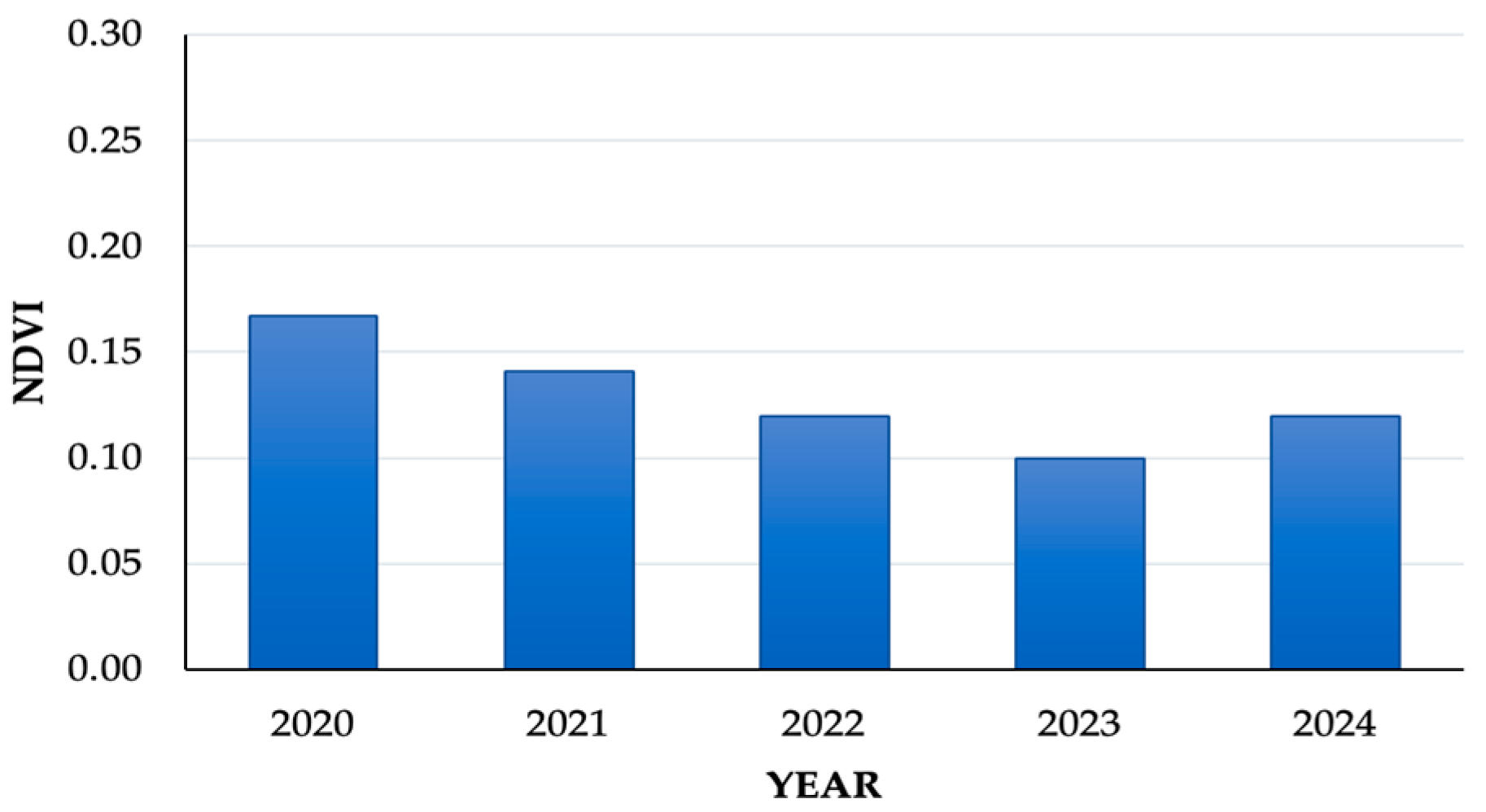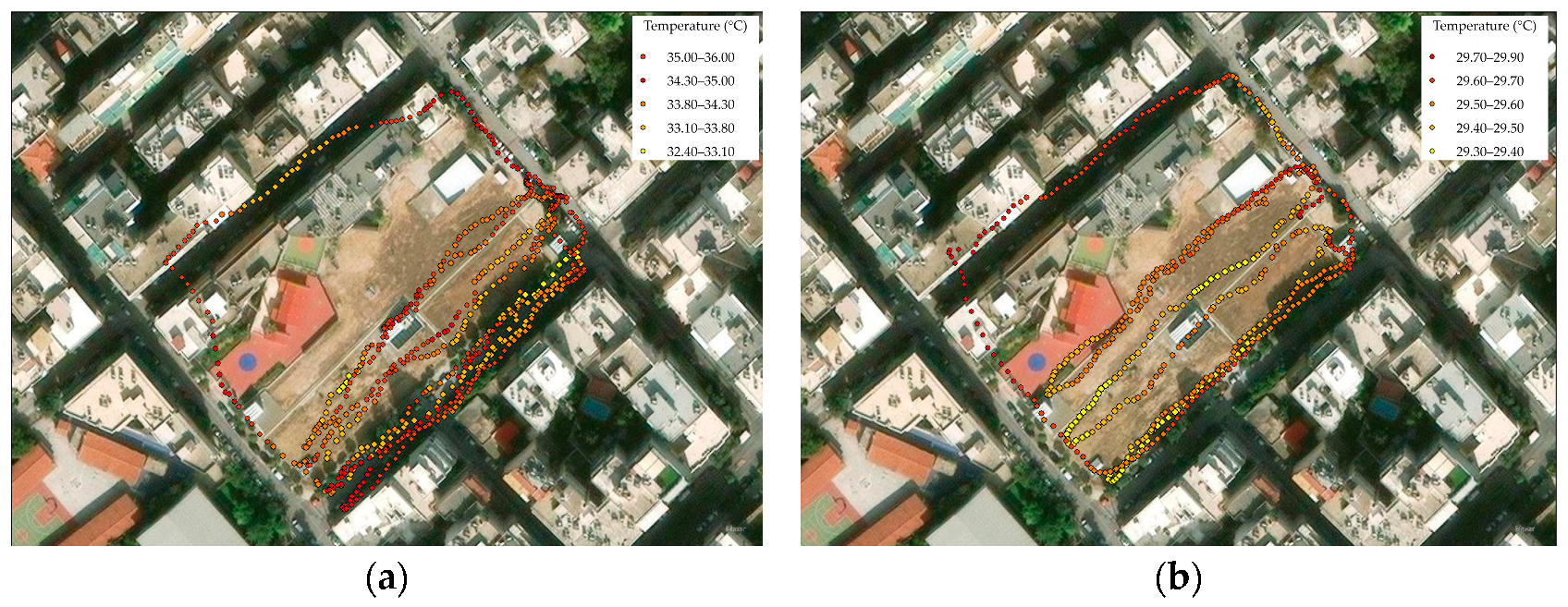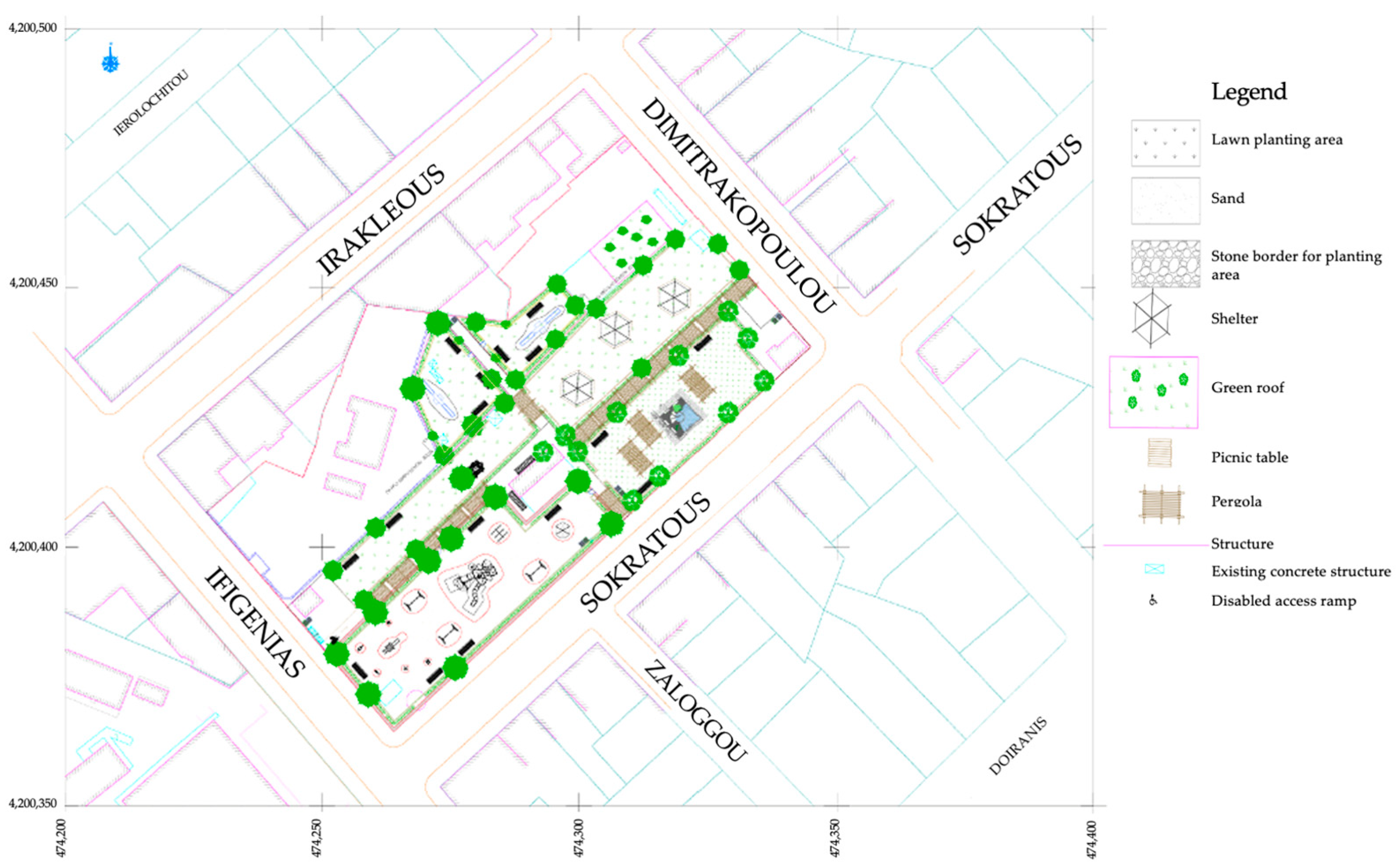Cooling Urban Municipalities Through Sustainable Microclimate Interventions: The Case of Kallithea in the Greater Athens Area †
Abstract
1. Introduction
2. Materials and Methods
3. Results
4. Discussion and Conclusions
Author Contributions
Funding
Institutional Review Board Statement
Informed Consent Statement
Data Availability Statement
Conflicts of Interest
References
- Oke, T.R. Boundary Layer Climates, 2nd ed.; Methuen: London, UK; New York, NY, USA, 1987; pp. 1–435. [Google Scholar]
- Founda, D.; Pierros, F.; Petrakis, M.; Zerefos, C. Interdecadal variations and trends of the urban heat island in Athens (Greece) and its response to heat waves. Atmos. Res. 2015, 161–162, 1–13. [Google Scholar] [CrossRef]
- Iodice, S.; Arbau, L.C.; Maistrali, A.; Marando, F.; Melchiorri, M.; Proietti, P.; Sulis, P.; Tainguy, O.; Vandecasteele, I. EU Cities and Heat Extremes; European Commission: Luxembourg, 2024. [Google Scholar]
- European Commission. The European Green Deal (COM/2019/640 Final); European Commission: Brussels, Belgium, 2019; Available online: https://eur-lex.europa.eu/legal-content/EN/TXT/?uri=CELEX:52019DC0640 (accessed on 24 September 2025).
- European Commission. Green Infrastructure (GI)—Enhancing Europe’s Natural Capital; EC: Brussels, Belgium, 2013; Available online: https://ec.europa.eu/environment/nature/ecosystems/strategy/index_en.htm (accessed on 24 September 2025).
- United Nations. Transforming Our World: The 2030 Agenda for Sustainable Development; United Nations: New York, NY, USA, 2015; Available online: https://sdgs.un.org/2030agenda (accessed on 24 September 2025).
- Zittis, G.; Almazroui, M.; Alpert, P.; Ciais, P.; Cramer, W.; Dahdal, Y.; Fnais, M.; Francis, D.; Hadjinicolaou, P.; Howari, F.; et al. Climate change and weather extremes in the Eastern Mediterranean and Middle East. Rev. Geophys. 2022, 60, e2021RG000762. [Google Scholar] [CrossRef]
- Stavrianos, N.M.; Agathangelidis, I.; Cartalis, C.; Giannaros, C. Exploring the impact of Local Climate Zones to the efficacy of cooling materials at the urban scale. In Proceedings of the EGU General Assembly 2024, Vienna, Austria, 14–19 April 2024. [Google Scholar] [CrossRef]
- Naumann, S.; Davis, M.; Kaphengst, T.; Pieterse, M.; Rayment, M. Design, Implementation and Cost Elements of Green Infrastructure Projects; Final Report; European Commission: Brussels, Belgium, 2011; p. 138. [Google Scholar]




| Indicator | Min. Value | Max. Value | Interpretation |
|---|---|---|---|
| Air Temperature (°C) | 33.0 °C | 36.0 °C | Very high values negatively affect thermal comfort |
| Wet Bulb Temperature (°C) | 20.0 °C | 25.0 °C | Borderline values indicating increased thermal stress |
| NA WBGT (°C) | 27.8 °C | 28.6 °C | Thermal strain at a dangerous level |
| Relative Humidity (%) | ~30.0% | ~55.0% | Quite high – may hinder sweat evaporation |
| Dew Point (°C) | ~10.0 °C | ~25.0 °C | High – impairs the body’s ability to release heat |
| Wind Chill (°C) | ~33.0 °C | ~33.0 °C | Minimal effect due to weak wind |
| Indicator | Min. Value | Max. Value | Interpretation |
|---|---|---|---|
| Air Temperature (°C) | 29.0 °C | 30.0 °C | Slightly decreased. |
| Wet Bulb Temperature (°C) | 18.5 °C | 21.0 °C | Gradual drop, yet insufficient to relieve the daytime heat stress |
| NA WBGT (°C) | 18.0 °C | 22.0 °C | High values—lead to poor sleep quality and hinder recovery from thermal strain. |
| Relative Humidity (%) | ~35.0% | ~45.0% | Quite high—creates a heavy atmosphere, poor sleep quality, and limits cooling. |
| Dew Point (°C) | ~13.0 °C | ~18.0 °C | Relatively low—perceived as almost dry air. |
| Zone | Area (m2) | Estimated Cost (€) | Zone | Area (m2) | Estimated Cost (€) |
|---|---|---|---|---|---|
| Green roof | 160 | 22,400–40,000 | Pathways (various materials) | 400 | 24,000–32,000 |
| Playground | 1200 | 36,000–48,000 | Furniture and fencing | - | 20,000–30,000 |
| Fountain | 800 | 320,000–480,000 | Irrigation and electricity | - | 10,000–20,000 |
| Dog park | 900 | 37,500 | Autonomy and digital technology | - | 10,000–15,000 |
| Green zones | 1200 | 18,000–36,000 | Total | 498,000–719,000 |
Disclaimer/Publisher’s Note: The statements, opinions and data contained in all publications are solely those of the individual author(s) and contributor(s) and not of MDPI and/or the editor(s). MDPI and/or the editor(s) disclaim responsibility for any injury to people or property resulting from any ideas, methods, instructions or products referred to in the content. |
© 2025 by the authors. Licensee MDPI, Basel, Switzerland. This article is an open access article distributed under the terms and conditions of the Creative Commons Attribution (CC BY) license (https://creativecommons.org/licenses/by/4.0/).
Share and Cite
Stavropoulos, T.; Feloni, E.; Prokopiadi, C.-C.; Sklia, M.; Hloupis, G.; Nastos, P.T. Cooling Urban Municipalities Through Sustainable Microclimate Interventions: The Case of Kallithea in the Greater Athens Area. Environ. Earth Sci. Proc. 2025, 35, 45. https://doi.org/10.3390/eesp2025035045
Stavropoulos T, Feloni E, Prokopiadi C-C, Sklia M, Hloupis G, Nastos PT. Cooling Urban Municipalities Through Sustainable Microclimate Interventions: The Case of Kallithea in the Greater Athens Area. Environmental and Earth Sciences Proceedings. 2025; 35(1):45. https://doi.org/10.3390/eesp2025035045
Chicago/Turabian StyleStavropoulos, Thomas, Elissavet Feloni, Chrysovalanti-Charikleia Prokopiadi, Maria Sklia, George Hloupis, and Panagiotis T. Nastos. 2025. "Cooling Urban Municipalities Through Sustainable Microclimate Interventions: The Case of Kallithea in the Greater Athens Area" Environmental and Earth Sciences Proceedings 35, no. 1: 45. https://doi.org/10.3390/eesp2025035045
APA StyleStavropoulos, T., Feloni, E., Prokopiadi, C.-C., Sklia, M., Hloupis, G., & Nastos, P. T. (2025). Cooling Urban Municipalities Through Sustainable Microclimate Interventions: The Case of Kallithea in the Greater Athens Area. Environmental and Earth Sciences Proceedings, 35(1), 45. https://doi.org/10.3390/eesp2025035045









